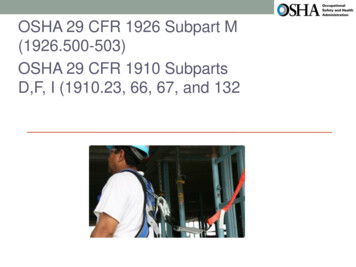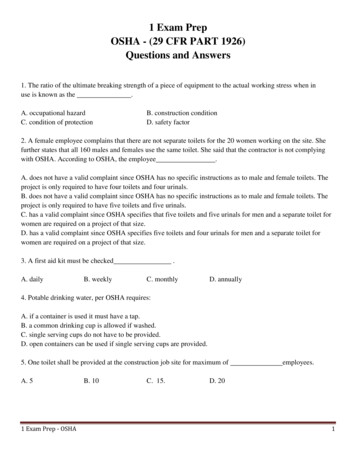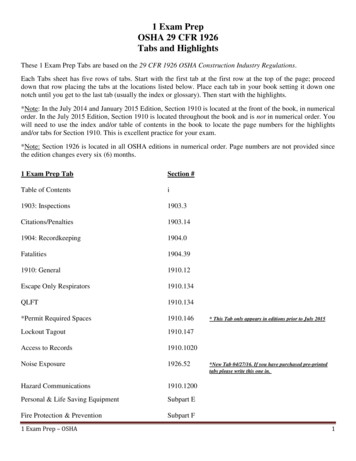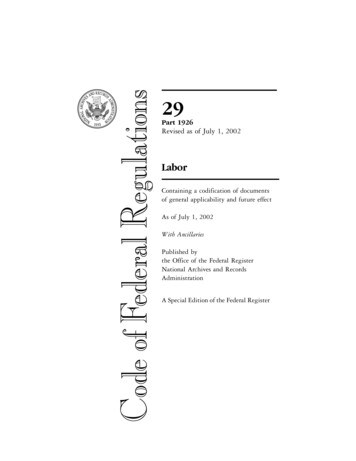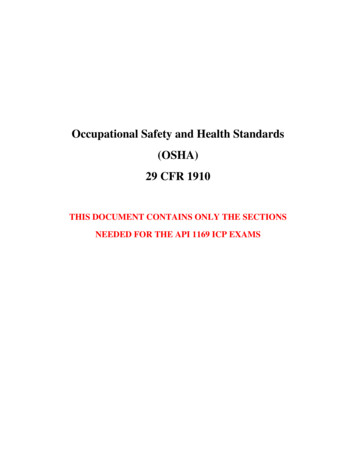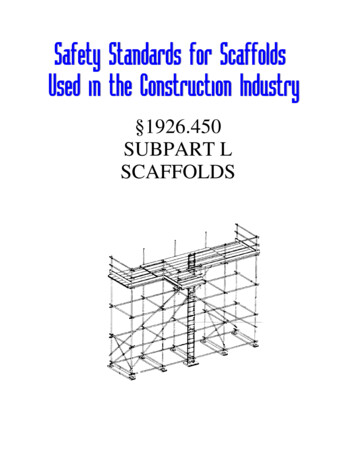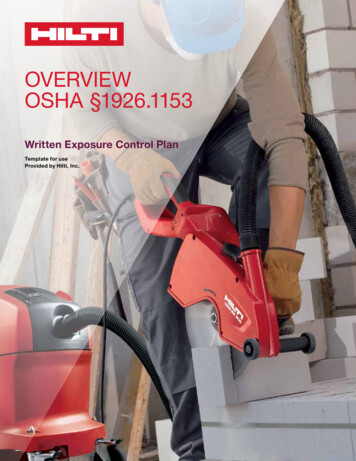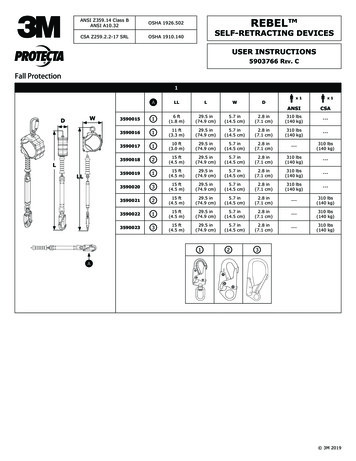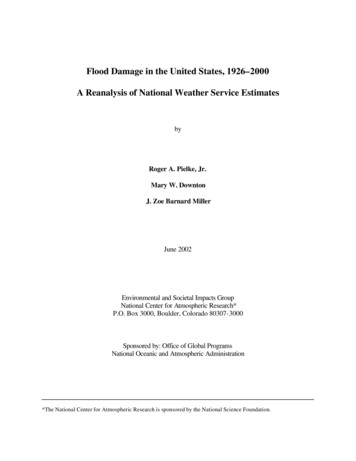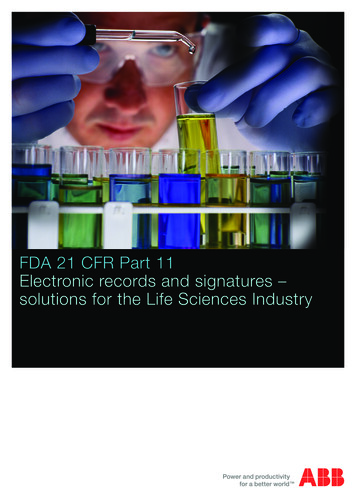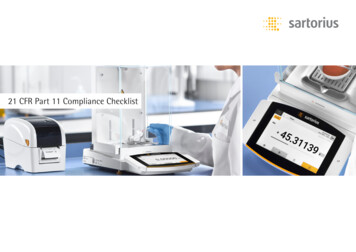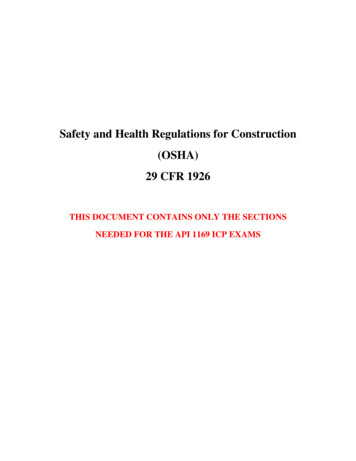
Transcription
Safety and Health Regulations for Construction(OSHA)29 CFR 1926THIS DOCUMENT CONTAINS ONLY THE SECTIONSNEEDED FOR THE API 1169 ICP EXAMS
SectionsSubpart C—General Safety and Health Provisions§1926.20 General safety and health provisions.§1926.21 Safety training and education.§1926.23 First aid and medical attention.§1926.24 Fire protection and prevention.§1926.25 Housekeeping.§1926.26 Illumination.§1926.27 Sanitation.§1926.28 Personal protective equipment.§1926.29 Acceptable certifications.§1926.30 Shipbuilding and ship repairing.§1926.32 Definitions.§1926.33 Access to employee exposure and medical records.§1926.34 Means of egress.§1926.35 Employee emergency action plans.Subpart D—Occupational Health and Environmental Controls§1926.62 Lead.Subpart E—Personal Protective and Life Saving Equipment§1926.102 Eye and face protection.Subpart F—Fire Protection and Prevention§1926.152 Flammable liquids.Subpart H—Materials Handling, Storage, Use, and Disposal§1926.250 General requirements for storage.§1926.251 Rigging equipment for material handling.Subpart L—Scaffolds§1926.451 General requirements.Subpart M—Fall Protection§1926.500 Scope, application, and definitions applicable to this subpart.
§1926.501 Duty to have fall protection.Subpart O—Motor Vehicles, Mechanized Equipment, and Marine Operations§1926.601 Motor vehicles.Subpart P—Excavations§1926.650 Scope, application, and definitions applicable to this subpart.§1926.651 Specific excavation requirements.§1926.652 Requirements for protective systems.Appendix A to Subpart P of Part 1926—Soil ClassificationAppendix B to Subpart P of Part 1926—Sloping and BenchingAppendix C to Subpart P of Part 1926—Timber Shoring for TrenchesAppendix D to Subpart P of Part 1926—Aluminum Hydraulic Shoring for TrenchesAppendix E to Subpart P of Part 1926—Alternatives to Timber ShoringAppendix F to Subpart P of Part 1926—Selection of Protective SystemsSubpart U—Blasting and the Use of Explosives§1926.902 Surface transportation of explosives.§1926.914 Definitions applicable to this subpart.Subpart CC—Cranes and Derricks in Construction§1926.1417 Operation.
29 CFR 1926 (OSHA)Subpart C—General Safety and Health ProvisionsAUTHORITY: 40 U.S.C. 3701 et seq.; 29 U.S.C. 653, 655, 657; Secretary of Labor's Order No. 12-71(36 FR 8754), 8-76 (41 FR 25059), 9-83 (48 FR 35736), 6-96 (62 FR 111), 5-2007 (72 FR 31160), or 12012 (77 FR 3912) as applicable; and 29 CFR part 1911.§1926.20 General safety and health provisions.(a) Contractor requirements. (1) Section 107 of the Act requires that it shall be a condition of eachcontract which is entered into under legislation subject to Reorganization Plan Number 14 of 1950 (64Stat. 1267), as defined in §1926.12, and is for construction, alteration, and/or repair, including paintingand decorating, that no contractor or subcontractor for any part of the contract work shall require anylaborer or mechanic employed in the performance of the contract to work in surroundings or underworking conditions which are unsanitary, hazardous, or dangerous to his health or safety.(b) Accident prevention responsibilities. (1) It shall be the responsibility of the employer to initiateand maintain such programs as may be necessary to comply with this part.(2) Such programs shall provide for frequent and regular inspections of the job sites, materials, andequipment to be made by competent persons designated by the employers.(3) The use of any machinery, tool, material, or equipment which is not in compliance with anyapplicable requirement of this part is prohibited. Such machine, tool, material, or equipment shall eitherbe identified as unsafe by tagging or locking the controls to render them inoperable or shall be physicallyremoved from its place of operation.(4) The employer shall permit only those employees qualified by training or experience to operateequipment and machinery.(c) The standards contained in this part shall apply with respect to employments performed in aworkplace in a State, the District of Columbia, the Commonwealth of Puerto Rico, the Virgin Islands,American Samoa, Guam, Trust Territory of the Pacific Islands, Wake Island, Outer Continental Shelflands defined in the Outer Continental Shelf Lands Act, Johnston Island, and the Canal Zone.(d) (1) If a particular standard is specifically applicable to a condition, practice, means, method,operation, or process, it shall prevail over any different general standard which might otherwise beapplicable to the same condition, practice, means, method, operation, or process.(2) On the other hand, any standard shall apply according to its terms to any employment and placeof employment in any industry, even though particular standards are also prescribed for the industry to theextent that none of such particular standards applies.(e) In the event a standard protects on its face a class of persons larger than employees, the standardshall be applicable under this part only to employees and their employment and places of employment.(f) Compliance duties owed to each employee—(1) Personal protective equipment. Standards in thispart requiring the employer to provide personal protective equipment (PPE), including respirators andother types of PPE, because of hazards to employees impose a separate compliance duty with respect to1
29 CFR 1926 (OSHA)each employee covered by the requirement. The employer must provide PPE to each employee requiredto use the PPE, and each failure to provide PPE to an employee may be considered a separate violation.(2) Training. Standards in this part requiring training on hazards and related matters, such asstandards requiring that employees receive training or that the employer train employees, provide trainingto employees, or institute or implement a training program, impose a separate compliance duty withrespect to each employee covered by the requirement. The employer must train each affected employee inthe manner required by the standard, and each failure to train an employee may be considered a separateviolation.[44 FR 8577, Feb. 9, 1979; 44 FR 20940, Apr. 6, 1979, as amended at 58 FR 35078, June 30, 1993; 73FR 75588, Dec. 12, 2008]§1926.21 Safety training and education.(a) General requirements. The Secretary shall, pursuant to section 107(f) of the Act, establish andsupervise programs for the education and training of employers and employees in the recognition,avoidance and prevention of unsafe conditions in employments covered by the act.(b) Employer responsibility. (1) The employer should avail himself of the safety and health trainingprograms the Secretary provides.(2) The employer shall instruct each employee in the recognition and avoidance of unsafe conditionsand the regulations applicable to his work environment to control or eliminate any hazards or otherexposure to illness or injury.(3) Employees required to handle or use poisons, caustics, and other harmful substances shall beinstructed regarding the safe handling and use, and be made aware of the potential hazards, personalhygiene, and personal protective measures required.(4) In job site areas where harmful plants or animals are present, employees who may be exposedshall be instructed regarding the potential hazards, and how to avoid injury, and the first aid procedures tobe used in the event of injury.(5) Employees required to handle or use flammable liquids, gases, or toxic materials shall beinstructed in the safe handling and use of these materials and made aware of the specific requirementscontained in subparts D, F, and other applicable subparts of this part.[44 FR 8577, Feb. 9, 1979; 44 FR 20940, Apr. 6, 1979, as amended at 80 FR 25518, May 4, 2015]§1926.22 Recording and reporting of injuries. [Reserved]§1926.23 First aid and medical attention.First aid services and provisions for medical care shall be made available by the employer for everyemployee covered by these regulations. Regulations prescribing specific requirements for first aid,medical attention, and emergency facilities are contained in subpart D of this part.2
29 CFR 1926 (OSHA)§1926.24 Fire protection and prevention.The employer shall be responsible for the development and maintenance of an effective fireprotection and prevention program at the job site throughout all phases of the construction, repair,alteration, or demolition work. The employer shall ensure the availability of the fire protection andsuppression equipment required by subpart F of this part.§1926.25 Housekeeping.(a) During the course of construction, alteration, or repairs, form and scrap lumber with protrudingnails, and all other debris, shall be kept cleared from work areas, passageways, and stairs, in and aroundbuildings or other structures.(b) Combustible scrap and debris shall be removed at regular intervals during the course ofconstruction. Safe means shall be provided to facilitate such removal.(c) Containers shall be provided for the collection and separation of waste, trash, oily and used rags,and other refuse. Containers used for garbage and other oily, flammable, or hazardous wastes, such ascaustics, acids, harmful dusts, etc. shall be equipped with covers. Garbage and other waste shall bedisposed of at frequent and regular intervals.§1926.26 Illumination.Construction areas, aisles, stairs, ramps, runways, corridors, offices, shops, and storage areas wherework is in progress shall be lighted with either natural or artificial illumination. The minimumillumination requirements for work areas are contained in subpart D of this part.§1926.27 Sanitation.Health and sanitation requirements for drinking water are contained in subpart D of this part.§1926.28 Personal protective equipment.(a) The employer is responsible for requiring the wearing of appropriate personal protectiveequipment in all operations where there is an exposure to hazardous conditions or where this partindicates the need for using such equipment to reduce the hazards to the employees.(b) Regulations governing the use, selection, and maintenance of personal protective and lifesavingequipment are described under subpart E of this part.§1926.29 Acceptable certifications.(a) Pressure vessels. Current and valid certification by an insurance company or regulatory authorityshall be deemed as acceptable evidence of safe installation, inspection, and testing of pressure vesselsprovided by the employer.(b) Boilers. Boilers provided by the employer shall be deemed to be in compliance with therequirements of this part when evidence of current and valid certification by an insurance company orregulatory authority attesting to the safe installation, inspection, and testing is presented.3
29 CFR 1926 (OSHA)(c) Other requirements. Regulations prescribing specific requirements for other types of pressurevessels and similar equipment are contained in subparts F and O of this part.§1926.30 Shipbuilding and ship repairing.(a) General. Shipbuilding, ship repairing, alterations, and maintenance performed on ships underGovernment contract, except naval ship construction, is work subject to the Act.(b) Applicable safety and health standards. For the purpose of work carried out under this section,the safety and health regulations in part 1915 of this title, Shipyard Employment, shall apply.[44 FR 8577, Feb. 9, 1979; 44 FR 20940, Apr. 6, 1979, as amended at 61 FR 9249, Mar. 7, 1996]§1926.32 Definitions.The following definitions shall apply in the application of the regulations in this part:(a) Act means section 107 of the Contract Work Hours and Safety Standards Act, commonly knownas the Construction Safety Act (86 Stat. 96; 40 U.S.C. 333).(b) ANSI means American National Standards Institute.(c) Approved means sanctioned, endorsed, accredited, certified, or accepted as satisfactory by a dulyconstituted and nationally recognized authority or agency.(d) Authorized person means a person approved or assigned by the employer to perform a specifictype of duty or duties or to be at a specific location or locations at the jobsite.(e) Administration means the Occupational Safety and Health Administration.(f) Competent person means one who is capable of identifying existing and predictable hazards inthe surroundings or working conditions which are unsanitary, hazardous, or dangerous to employees, andwho has authorization to take prompt corrective measures to eliminate them.(g) Construction work. For purposes of this section, Construction work means work forconstruction, alteration, and/or repair, including painting and decorating.(h) Defect means any characteristic or condition which tends to weaken or reduce the strength of thetool, object, or structure of which it is a part.(i) Designated person means “authorized person” as defined in paragraph (d) of this section.(j) Employee means every laborer or mechanic under the Act regardless of the contractualrelationship which may be alleged to exist between the laborer and mechanic and the contractor orsubcontractor who engaged him. “Laborer and mechanic” are not defined in the Act, but the identicalterms are used in the Davis-Bacon Act (40 U.S.C. 276a), which provides for minimum wage protectionon Federal and federally assisted construction contracts. The use of the same term in a statute which oftenapplies concurrently with section 107 of the Act has considerable precedential value in ascertaining themeaning of “laborer and mechanic” as used in the Act. Laborer generally means one who performs4
29 CFR 1926 (OSHA)manual labor or who labors at an occupation requiring physical strength; mechanic generally means aworker skilled with tools. See 18 Comp. Gen. 341.(k) Employer means contractor or subcontractor within the meaning of the Act and of this part.(l) Hazardous substance means a substance which, by reason of being explosive, flammable,poisonous, corrosive, oxidizing, irritating, or otherwise harmful, is likely to cause death or injury.(m) Qualified means one who, by possession of a recognized de
29 CFR 1926 (OSHA) 4 (c) Other requirements. Regulations prescribing specific requirements for other types of pressure vessels and similar equipment are contained in subparts F and O of this part. §1926.30 Shipbuilding and ship repairing. (a) General. Shipbuilding, ship repairing, alterations, and maintenance performed on ships under Government contract, except naval ship construction, is .
